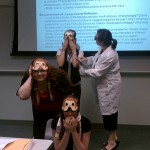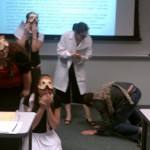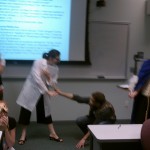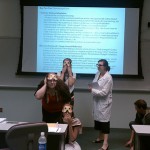Trying hard not to be intimidated by a room full of powerhouse teachers, was a lofty goal. Thank you all for participating and helping me through my lesson on Marriage à la Mode. Explaining the obvious is elusive: just when I thought I was explaining some aspect of a literary term, I realized I did not scaffold the discussion with explicit instruction, so my questions might have seemed ambiguous. In addition, I posted the assignment a week earlier than it was due, and, with so many pieces to look at, I was afraid that you all might have read it the previous week, so it would not be fresh in your minds. I apologize for the misunderstanding.
I think the lesson plan would have been more substantial had I reversed the order of my two integrative models: the concept map and the PowerPoint. Since my backend design was concept attainment, a more comprehensive plan might have begun with a quick introduction and student summary, prior to viewing the ppt. (In class, I usually go through my ppts. two times: once with the lights off, and then again, after disseminating the handouts, with the lights half on so the students can take notes on the prepunched pages.). Afterward, I would have had time to quietly assess areas of difficulty and get feedback from the class about ideas that needed further elaboration.
My assignments were buried in the presentation, and I think it would been key to be able to stop and concentrate on those, and on how they were structured. If your still have the handout, I would appreciate any feedback on the assignment (and on any other area on which you want to comment). We are constantly trying to collect a “common assessment” based on fulfilling the requirements on the SOL’s, and I wanted to see how my peers assessed the validity and value of this method.
Finally, (in a perfect universe which is currently inaccessible to me), I would have finished ahead of the bell with enough time to explain the concept map, the skills students use to decipher them, and a foregrounding of some of the major branches to get the class started. I had wanted it to be more enjoyable than laborious. I was really tickled when Todd figured out the branch for “symbols,” and some of you laughed.
[In case you are interested in seeing the fly-ins and animation, I will send the ppt. by e-mail. I am not a master of this venue, but I enjoy making them. To see all the effects, you have to be in full screen mode. I use a remote control clicker so I can be at the back of the classroom when students watch the presentation. I will also include the concept map. Schools can buy licenses, or, you can order the software from Inspiration yourself. I had it for several years and did not think I had time to learn how to use it until Professor Sample suggested the concept map as an alternative in one of our assignments. I think it is an elegant way for your brain to put ideas in place.]
The second to the last page of the ppt. has a wonderful video by Dorling Kindersley’s Publishing about the end of literature and publishing, as we know it. It takes about two minutes; I was intending to end with it as a metaphor for expecting and getting a lot more from your students than you had anticipated: http://clivemcgoun.net/?p=1924
\"Future of Publishing\"



